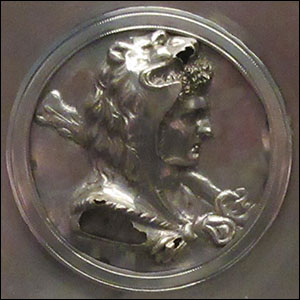
Who exactly was the real Herakles? The common misconception is that there was a semi-divine man named Herakles who was fathered by the god Zeus and born to a mortal woman. This Herakles died just prior to the Trojan War. The Labors of Herakles and the Quest for the Golden Fleece were the highlights of Herakles's life but as we dig deeper into his other deeds, we are confronted with the fact that Herakles also unchained Prometheus from the Caucasus Mountains. The encounter with Prometheus took place at the dawn of human existence and can in no way be reconciled with the time in which the traditional Herakles lived. There must therefore have been an ancient Herakles who freed Prometheus and lived thousands of years before the traditional Herakles. With those facts in mind, we can assume that the deeds and exploits of the two Herakles's have been blended and blurred to reflect the life of one individual.
The historical facts seem to get more and more counterintuitive as we dig deeper into the life of Herakles. There were at least two and possibly three hero-gods named Herakles. To say that there were three Herakles's is within the realm of possibility but the number two is more likely and seems sufficient to account for the ancient and traditional deeds attributed to Herakles.
The historian Herodotos mentions the probability that in addition to the traditional Herakles there was also an ancient Herakles. Diodorus of Sicily agrees that there was an ancient and traditional Herakles but also extends the possibility that there was a third hero-god named Herakles. This third Herakles would have lived several generations before the traditional Herakles and thousands of years after the ancient Herakles. Diodorus of Sicily does not specifically say that this Herakles was a son of Zeus.
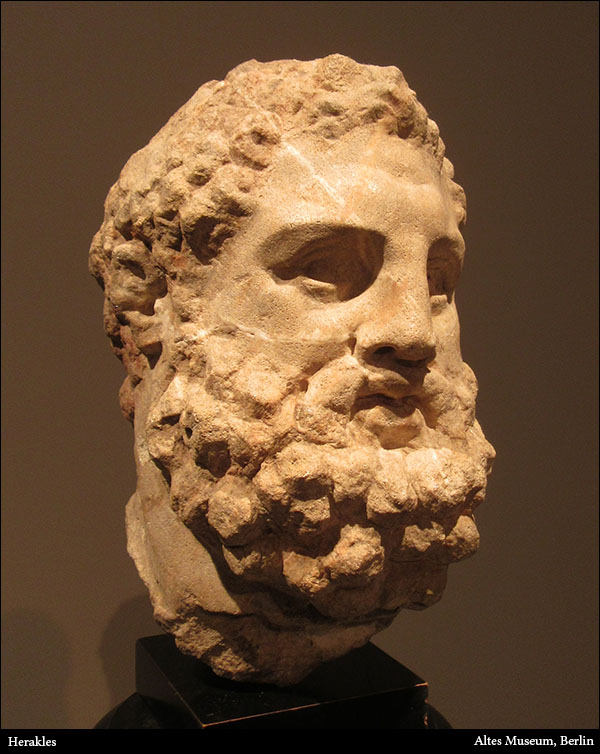
Herodotos relates an incident in Tyre, Phoenicia, where he saw, circa 450 BCE, a temple dedicated to Herakles that the priests said was established when the city was first founded ... that would be 2,300 years prior to Herodotos's inquiry. Herodotos also visited the island of Thasos where he was told that their temple of Herakles was established five generations before Herakles, the son of Alkmene, was born.
Diodorus of Sicily believed that there were three different hero-gods named Herakles. The first Herakles was descended from the Heifer-Maiden Io in Egypt ... he traveled the inhabited world and exceeded all men in strength and valor. He inflicted punishment on the unjust and killed the wild beasts that made the various lands uninhabitable. The second Herakles was one of the Idaean Daktyls who were named after the mountain on which they lived—Mount Ida on the island of Krete—they were best known as metal workers and magicians. The third Herakles was the son of Alkmene and emulated the life-plan of his predecessors to such an extent that many of the deeds of the first and second Herakles were in time transferred to the third Herakles.
To make a crude estimate as to the times in which the three Herakles' lived, we might consider the following:
The ancient Herakles—This Herakles killed the eagle Zeus sent to torment Prometheus ... he then broke the chains that held Prometheus to the side of the Caucasus Mountains. The ancient Herakles was born thirteen generations after the Heifer-Maiden Io settled in Egypt.
An interesting way to establish the age in which Prometheus lived is to consider the creation of the first woman, Pandora. Zeus commanded the god Hephaistos to chain Prometheus to a mountain and then mold earth into the shape of a modest young woman. Zeus then instructed other immortals to endow the earthly-creation with attributes that would make her irresistible to any mortal man. She was named Pandora ... meaning, endowed by all. As the first female of our species, Pandora's creation must have taken place approximately 40,000 years ago.
The second Herakles—The only clue we have in order to fit this Herakles into a time frame is that he lived at least five generations before the traditional Herakles. This would tentatively place the second Herakles in the time period preceding 1500 BCE.
The traditional Herakles—This is the Herakles of legend ... the Herakles of the Twelve Labors and one of the Argonauts who went in search of the Golden Fleece. This Herakles died and then became immortal shortly before the beginning of the Trojan War which would place his birth at approximately 1300 BCE.
Herakles is the beloved son of Zeus and a mortal woman named Alkmene. Herakles became the archetype for bravery and proof-positive that might makes right. According to the poet Hesiod, Alkmene bore two sons, not twins but brothers by blood. Herakles was fathered by Zeus and Iphikles was fathered by Alkmene's mortal husband, Amphitryon. Zeus assumed the guise of Amphitryon and prolonged the night for three times its normal length to lay with Alkmene. Hera, Zeus's sister-wife, resented the union and vented her wrath on Herakles at every opportunity.
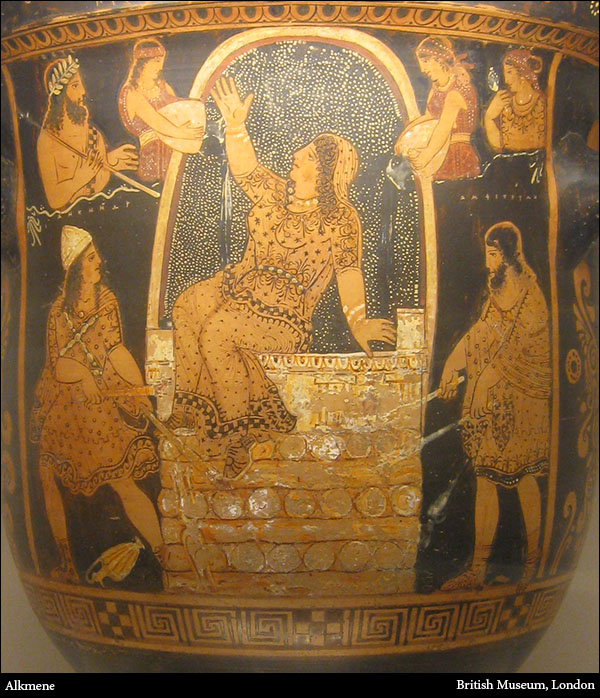
Herakles was perhaps the most renowned and important hero in ancient Greece. His semi-divine heritage and insatiable thirst for adventure made him one of the most popular men of his time but his reputation and spirit did not fade when he cast off his mortal body and ascended to the heights of Mount Olympos to live among the Immortals. His name is assumed to mean Hera's Glory ... a name given to him by the people of Argos because he gained glory (κλέος) with the aid of Hera. That explanation seems at odds with other facts ... for example, Hera did not embrace Herakles as a "son" until after he was made immortal ... while he was alive, Hera was hostile in the extreme. For those reasons it has been conjectured that the Theban Herakles (the son of Alkmene) simply took his name from the ancient Herakles.
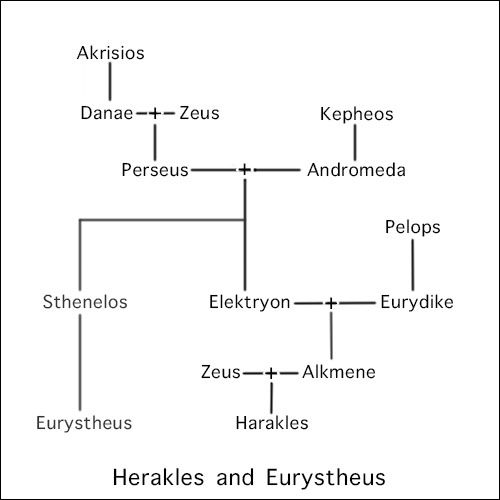
Since Herakles was not the son of Hera, he was subject to her rage. From the very beginning, his life was affected by Hera's vengeance and hostility. When Alkmene was pregnant with Herakles, Hera cleverly made Zeus swear a solemn oath that the next son born in the line of Perseus would become the ruler of Argos. Perseus was a son of Zeus and the implication was that the next child born of Zeus's bloodline would become the ruler of Argos. Zeus was certain Herakles would be that ruler, but Hera delayed Eileithyia, goddess of childbirth, from attending Alkmene and allowed Herakles's cousin Eurystheus to be born first. According to Zeus's oath, Herakles was thus obliged to do Eurystheus's bidding and perform the tasks known as the Twelve Labors of Herakles.
The second act of revenge directed towards Herakles by Hera was when she put two deadly snakes in his crib. Although Herakles was a mere infant, he managed to strangle the snakes with his bare hands. In many cases, the artwork depicting this event curiously shows Herakles, not as an infant, but as a mini-man.
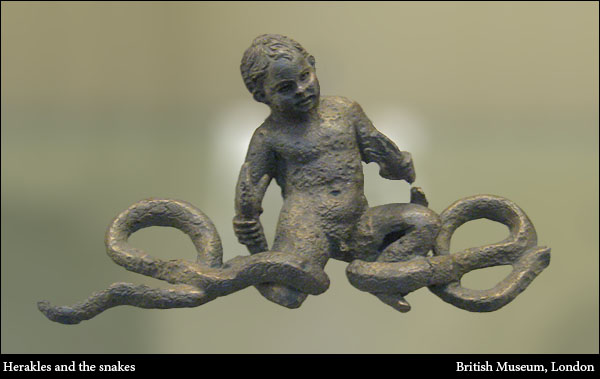
Even without the cruel intervention of Hera, Herakles was quite capable of causing death and destruction wherever he went. As part of his education, he and his brother Iphikles studied music from a master named Linus—said to have been the innovator of melody and rhythm, and the instructor of Orpheus, the greatest musician to ever live. During one of the lessons, Linus struck Herakles for his inattention ... the youthful Herakles flew into a rage and beat Linus to death with a stool.
By the time the exploits of Herakles were committed to paper, i.e. after 480 BCE, his adventures were greatly exaggerated and diluted but the essence of the ultimate hero was still preserved in the somewhat artificial classifications of Labors, Incidentals, and Deeds. The Labors (ἄθλον) were twelve tasks Herakles was obliged to undertake for his cousin, King Eurystheus of Argos. The Incidentals (πάρεργος) were adventures Herakles had during the course of his Labors. The Deeds (πράσσο) were various other feats and adventures that punctuated Herakles's glorious, yet troubled, mortal existence.
With armor and shield forged by the god Hephaistos, Herakles was more than a match for men and demigods alike. He ventured off into the world with Hera snapping at his heels and a lust for adventure in his heart. Herakles lived during the Age of Heroes—the fourth generation of mortal men on the earth. Half-man and half-god, he was the focus of considerable wrath and love from the Immortals.
Herakles's life was one of self-sacrifice and sadness. Strangely enough, Herakles (his "shade," that is) met and recognized Odysseus while Odysseus was in the Underworld seeking an oracle. Odysseus noted Herakles's terrible glance and his war costume. Herakles's belt and golden baldric were artistically designed with all manner of vicious beasts and graphic acts of manslaughter. Odysseus secretly hoped that the artist who designed those horrid images would never again display his craft. Herakles told Odysseus of the time he was sent to the Underworld to fetch the Hound of Hades, Kerberos. He asked Odysseus if he too was the victim of some wretched destiny, which of course, he was ... why else would he be in the Underworld while he was still living? Herakles described Eurystheus as "A man far worse than I, a rough master."
Even though Herakles resented the fact that he was bound to such an inferior man as Eurystheus, when the Centaur Homadus tried to force his affections on Eurystheus's daughter Alkyone, Herakles came to her defense and killed Homadus without hesitation. Herakles was praised for his actions by the people of Greece because they knew he had no love for Eurystheus but defended the helpless Alkyone in spite of his hostilities towards her father.
The life of Herakles was documented in artwork that predates any written account by as much as four hundred years. For this reason, I have compiled this brief explanation of his Labors, Incidentals, and Deeds from the surviving artwork instead of the later, understandably embellished, written versions.
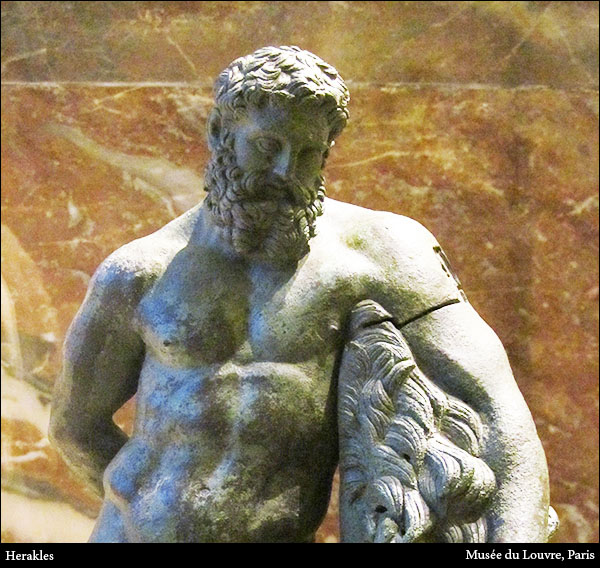
One of the most disturbing events of Herakles's troubled life was the murder of his children. While still a teenager, Herakles settled a dispute for King Kreon of Thebes ... as a reward for his services, Herakles was allowed to marry the king's daughter, Megara. After he and Megara had produced several children, the goddess Hera could not contain her contempt and cast a spell of confusion and rage on Herakles. With uncontrolled fury, he proceeded to kill his children. Some accounts say Herakles also killed Megara but different authors and examples of ancient artwork dispute that accusation.
After this tragic episode, Herakles went to the Oracle at Delphi to try and find redemption for this horrific crime. The Pythia, i.e. priestess of Apollon, told him to present himself to his cousin Eurystheus and do his bidding. The tasks assigned to him by his cousin Eurystheus are collectively known as The Labors of Herakles.
The chronology of the Twelve Labors is rather arbitrary but since the time of the Greek grammarian, Apollodorus Dysklus (circa 140 BCE), the numbering of the Labors has become literally written in stone. On the Temple of Zeus at Olympia, built in the mid-fifth century BCE, the only metope that depicts Herakles as beardless (i.e. young) is the scene where he stands with his foot on the dead Nemean lion. For that reason, it's understandable that killing of the Nemean lion is considered to be the First Labor of Herakles. The ordering of the other Labors is not quite as obvious, but we will yield to the authority of Apollodorus Dysklus.
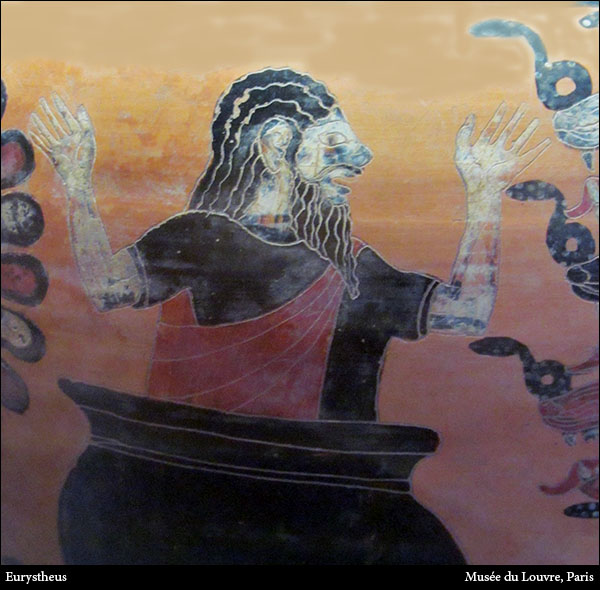
3) Capturing the Keryneian Hind
4) Capturing the Boar of Mount Erymanthos
5) Cleaning the Stables of Augeas
6) Killing the Stymphalian Birds
8) Capturing the Mares of Diomedes
9) Retrieving the Belt of Hippolyte
10) Taking the Cattle of Geryon
11) Retrieving the Golden Apples of Hesperides
12) Bringing Kerberos from the Underworld
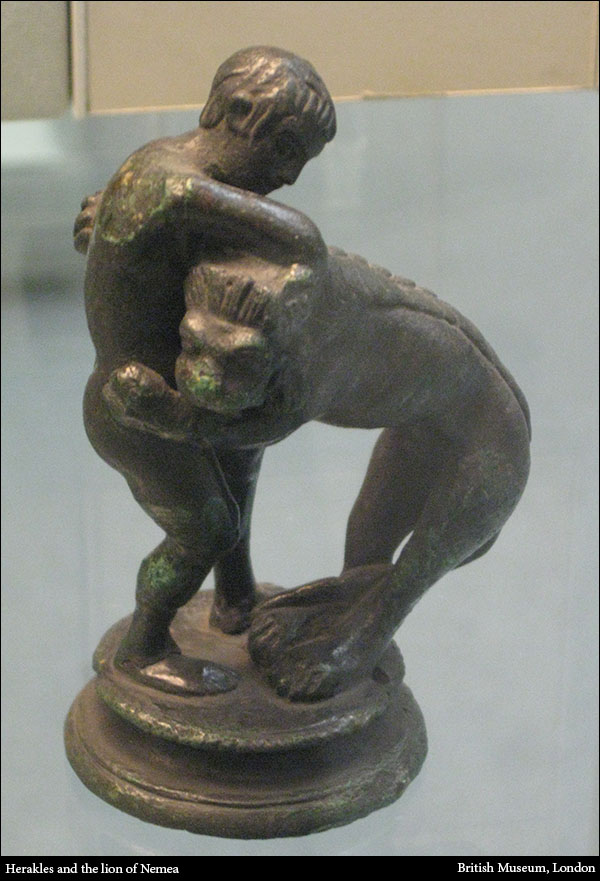
Nemea was a valley in southeast Greece, in ancient Argos. According to the poet Hesiod, the Nemean lion was the predatory offspring of the two-headed dog Orthos and the half-Nymph, half-serpent Ekhidna. Presumably the Nemean lion was the sister of the deadly Sphinx of the city of Thebes and the half-sister of Kerberos, the watchdog at the gates of the House of Hades. As you can deduce from her family, this was no ordinary beast that terrorized the travelers and livestock in the peaceful countryside around Nemea.
Eurystheus sent Herakles to kill the Nemean lion as the first of his Twelve Labors. Herakles wrestled with the lion and strangled it to death. Early artistic renderings of this wrestling match showed the lion on its hind feet fighting Herakles in the same manner two men would grapple ... after circa 530 BCE the lion and Herakles were usually shown on the ground, fighting like animals.
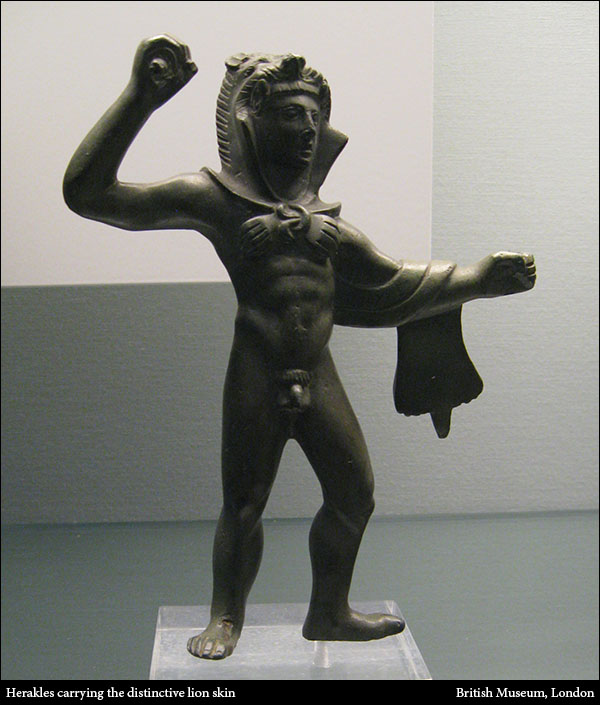
After killing the Nemean lion, Herakles skinned the beast and wore the pelt until it became iconic ... throughout the rest of his mortal life, Herakles wore the Nemean lion head atop his head and the skin either tied around his waist or worn like a cape.
According to the poet Hesiod, the Hydra was the offspring of the half-Nymph, half-serpent Ekhidna, and the snake-bodied Typhaon but he fails to describe the Hydra in detail. However, the Hydra's actual appearance was well documented in ancient artwork as a large multi-headed snake. This description agreed with later writers who said the Hydra had a huge body with eight mortal heads and one immortal head. The creature lurked in the swamps of Lerna, which was a marshy region near ancient Argos in southeast Greece on the Peloponnesian Peninsula. The artistic representations of this Labor date back to the end of the eighth century BCE, where a bearded Herakles was almost always assisted by his devoted nephew, Iolaos.
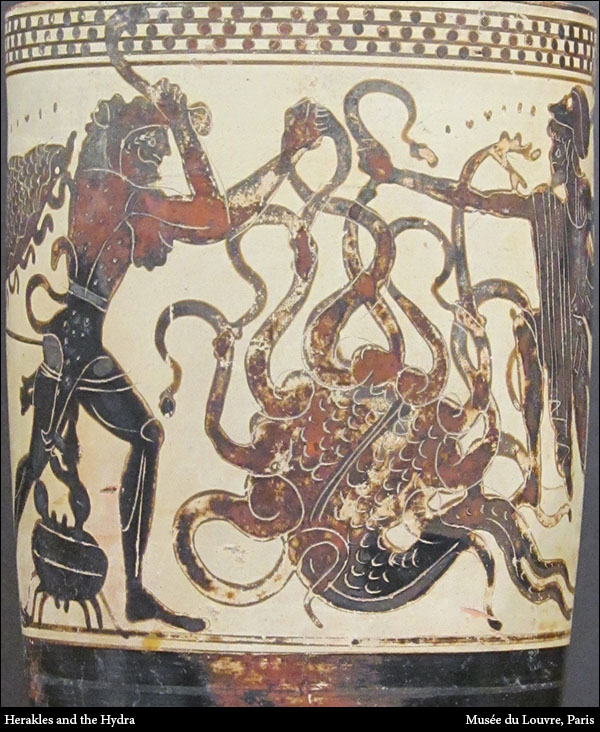
The Hydra was very hard to kill because each time one of the serpent-like heads was hacked off, two new heads grew to replace it. Also, the blood of the Hydra was a deadly poison.
With the help of Iolaos and with the goddess Athene watching the battle to lend her protection, Herakles attacked the Hydra. He used either a sword or a sickle to hack at the heads while a giant crab, sent by the vengeful Hera to distract him, snapped at his heels. To prevent the heads from growing back two-fold, Herakles succeeded in cauterizing the squirming necks with fire as he cut off each head. After the Hydra was dead, Herakles dipped his arrows in the poisonous blood ... an act he would regret during his Fourth Labor.
According to the chronology of Apollodorus, the Third Labor Eurystheus commanded of Herakles was the capture of the Keryneian Hind. This Labor is the subject of Attic artwork dating back to the mid-sixth century BCE and perhaps, but not definitely, to the eighth century. The hind, i.e. female deer, was portrayed with golden horns, which is indicative of a male deer, but such sexual ambiguity was not uncommon in Greek mythology. As an example of this sexual ambiguity, the Eighth Labor has Herakles capturing the mares of Diomedes, but the artwork of this Labor clearly depicts the mares as stallions.
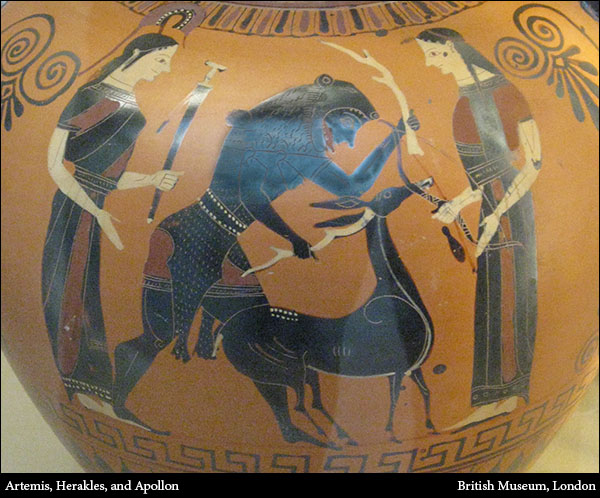
The Keryneian Hind was sacred to the goddess Artemis and was named after a Peloponnesian river. Herakles spent a year searching for the elusive deer before he was able to capture it. Later versions of this Labor show Herakles breaking off the horns of the hind and writers such as Euripides (circa 480-406 BCE), say the hind was killed, not captured, by Herakles.
While returning the hind to Eurystheus, Herakles encountered Artemis and her brother, Apollon. They demanded the return of the sacred creature, but Herakles successfully argued the justice of his quest and was allowed to complete his Labor. Several depictions of this encounter show Herakles and Apollon struggling over the hind in a sort of tug-of-war.
While representations of this Labor appear on the metopes of the Treasury of the Athenians at Delphi and the Temple of Zeus at Olympia, the topic is not to be found in non-Attic artwork before circa 350 BCE.
This, the Fourth Labor of Herakles, has the distinction of being the most tragic as well as the most comic of the Labors. The tragedy occurred when Herakles was forced to fight with some drunken Centaurs and during the course of the melee, two renowned Centaurs were accidentally killed. The comedic aspect of this labor came when Herakles returned the savage boar to his cousin Eurystheus ... when Herakles tried to give the boar to Eurystheus, the flustered and frightened king climbed into a pithos that was buried in the ground ... a pithos is a very large earthenware jar used for storage.
Erymanthos is a mountain in southern Greece on the northwest Peloponnesian Peninsula. To be rid of the deadly wild boar that was menacing the countryside around the mountain, Eurystheus commanded Herakles to capture the beast and deliver it to Mykenai alive. During his search for the boar, Herakles stopped at the dwelling of the Centaur, Pholos. When Pholos opened the wine pithos so he and Herakles could drink, the other, less civilized Centaurs started a ruckus. Herakles used his bow to drive off the intruders and accidentally wounded the noble Centaur Kheiron with an arrow poisoned with the blood of the Hydra. In the confusion of the confrontation Pholos dropped one of the poisoned arrows on his foot ... both Centaurs died from the poisonous Hydra blood.
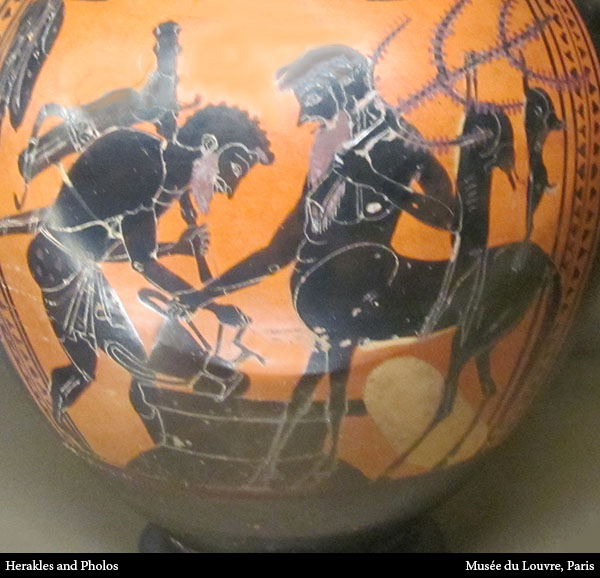
Artwork depicting the death of the Centaurs Kheiron and Pholos dates back to the early sixth century BCE including a frieze on the Temple of Athene at Assos. Representations of the capture of the boar date back to the late seventh century and often include Iolaos and Athene. Herakles is shown in various poses with the boar clutched to his breast, thrown over his shoulder and holding the boar's hind feet walking it like a wheelbarrow.
Arriving at Mykenai, Herakles presented the savage boar to Eurystheus who was hiding in a half-buried pithos in fear of the grisly beast ... a comic ending to an otherwise tragic Labor.
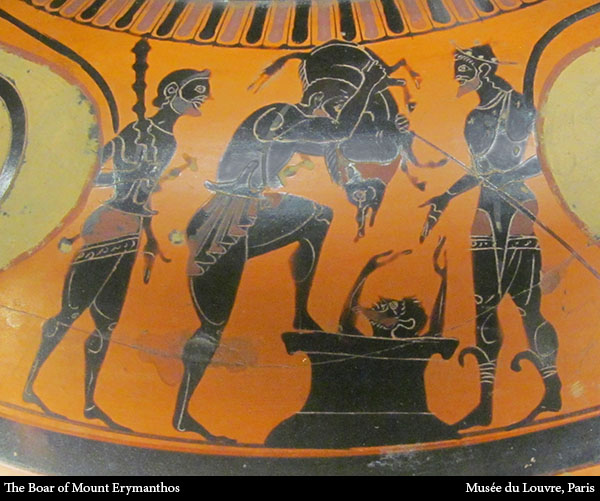
Augeas was the king of Elis, which was a country in western Greece on the Peloponnesian Peninsula and the site of the ancient Olympic Games. Eurystheus gave Herakles the lowly but formidable task of cleaning the king's stables in a single day.
For obvious reasons, Herakles did not want to clean the stables with his bare hands ... it was a demeaning task and not worth the ridicule and humiliation he was likely to endure if he emerged from the Labor covered with dung. He therefore undertook this Labor with the same shrewd combination of brain and brawn that characterized his other Labors. With the help of his protector Athene, he diverted the rivers Alpheios and Peneios to the stables and using a large wrecking bar, knocked a hole in the wall allowing the torrential waters to flush out the accumulated detritus.
The only surviving artwork of this Labor is the metope from the Temple of Zeus at Olympia and dates from the mid-fifth century BCE. Because of the lack of glamour, the minimal manliness and the absence of grandiose heroic ideals, this Labor was not a popular theme for ancient artists.
The first six Labors of Herakles are commonly called the "Peloponnesian Group" because they were all done on the Peloponnesian Peninsula. This, the Sixth Labor, is the last of the Peloponnesian Group and took place near Stymphalos, in Arkadia. Herakles was sent to kill the Stymphalian Birds either because they were a nuisance or, as later writers profess, because they were man-eaters.
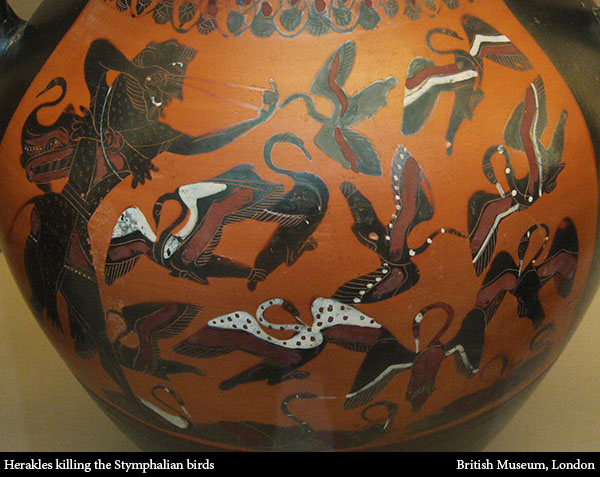
It's easy to believe that the classical Greeks, Romans and later writers (up to the present) weren't satisfied with the fragmentary condition of the ancient myths and sacrificed symbolism and subtlety for the sake of drama (like man-eating birds!) and thus inflicted their personal literary preferences on posterity ... for that reason I have tried to recount the earliest versions of the myths in the hopes of preserving the simple beauty and, sometimes, confusing nature of the fragments we still possess.
Herakles entered the woods around the lake near Stymphalos with his bow and a pair of krotalas—castanet-like clappers that were made by Hephaistos and given to Herakles by Athene. The idea was to frighten the birds with the krotalas and then shoot them with his bow when they took flight. This Labor doesn't seem too dangerous or laborious but we can only assume the task was beyond the abilities of other men simply because Herakles was sent to do it.
There are a few black-figured vases portraying this Labor that date back to the mid-sixth century BCE and also a metope on the Temple of Zeus at Olympia (mid-fifth century BCE) with Herakles giving what appears to be dead birds to Athene.
In this Labor, Herakles had to go to the island of Krete and bring back a savage bull to Eurystheus in Mykenai. The principal aspect of this Labor is simply the size and strength of the bull. It seems likely that Eurystheus wanted the bull brought to him to symbolize his virility and perhaps more importantly, to demonstrate his dominance over Herakles.
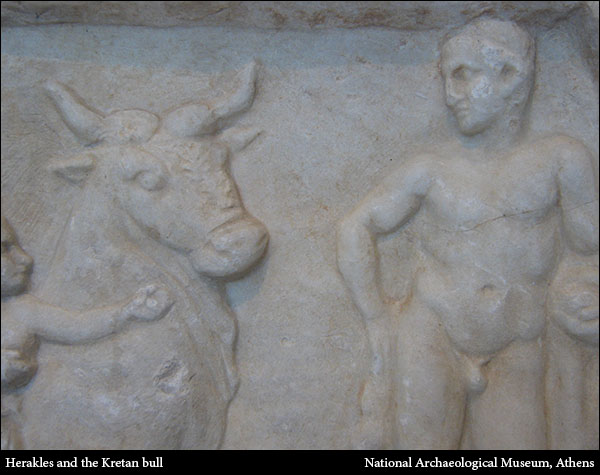
The earliest depiction of this Labor seems to be from 550 BCE. However, there are numerous Attic black-figured vases from the late sixth century and early fifth century with Herakles either fighting or leading the bull. Some versions of this Labor indicate that after the bull was presented to Eurystheus it was set free and made its way to the fields of Marathon where it was finally captured by the Athenian hero Theseus and ultimately sacrificed to the god Apollon.
Diomedes was king of Bistones, in Thrake. He was also a son of Ares, god of war, and true to his bloodthirsty heritage and to keep his mares battle-keen, Diomedes fed the mares human flesh. It's not clear whether Herakles accomplished this Labor alone or if he enlisted a group of soldiers to assist him. It's also not clear whether Diomedes was killed defending his horrible horses or if Herakles fed him to the mares as a just desert. Regardless, Diomedes died for his savage behavior and Herakles took the mares back to Eurystheus in Mykenai.
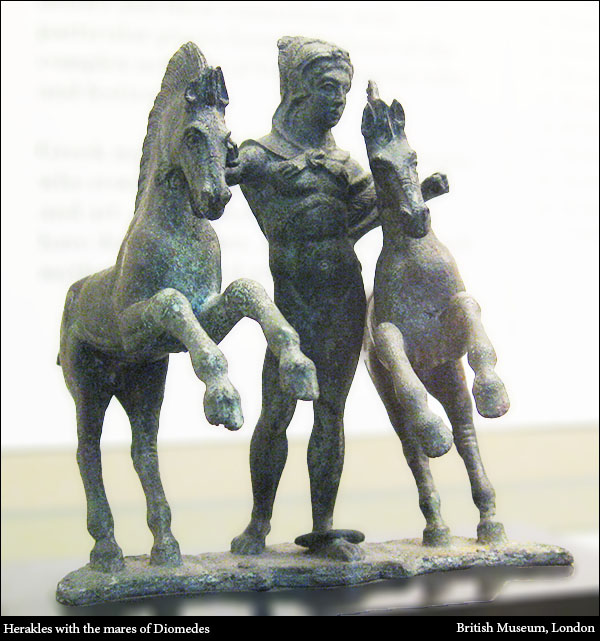
The earliest artistic depiction of this Labor appears on archaic Attic vases and cups. The Archaic Period was roughly from the sixth century BCE until the sack of Athens by the Persians in 480 BCE. On some of the archaic cups (circa 520 BCE) the mares of Diomedes are clearly stallions ... again, as with the Keryneian Hind, we have deliberate sexual ambiguity. This ambiguity was not restricted to animals ... even the beautiful goddess Artemis was sometimes called "The Bull Goddess."
Hippolyte was queen of the Amazons but, as we will see, she was as much a mystery as the legendary Amazons she represented. The Amazons were a tribe (or society, if you prefer) of female warriors who lived at the fringe of the civilized world beyond the shores of the Black Sea. The historian Herodotos said the Skythians called the Amazons Oeorpata, which is the equivalent of "mankillers" ... Orer being the Skythian word for "man" and Pata for "kill."
In this, the Ninth Labor of Herakles, we are faced with several questions for which there are no definite answers: 1) did Herakles go on this Labor alone or did he take other soldiers with him, 2) did Herakles kill the Amazon queen or did he simply subdue her and take her belt—the mid-fifth century BCE metope from the Temple of Zeus at Olympia shows Herakles standing over the fallen queen with his club raised as if to strike her, and 3) was the queen of the Amazons named Hippolyte, Andromeda, or Andromakhe?
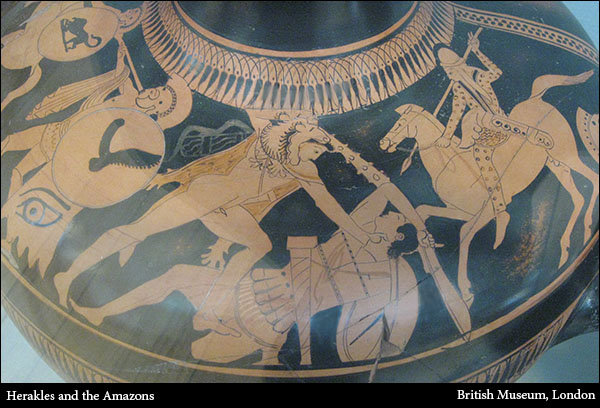
Judging by the surviving artwork of this Labor it seems to be almost as popular as the First Labor, i.e. killing the Nemean Lion, which was by far the most popular artistic theme associated with Herakles. The oldest definite depiction of the Ninth Labor shows Herakles with the Amazon queen Andromeda on a late seventh century BCE Korinthian alabastron (a jar for oils, ointments and perfumes) ... later Attic depictions name the queen as Andromakhe. The first written accounts of this Labor did not appear until hundreds of years later ... by then the queen was named Hippolyte. The early representations of this Labor always show Herakles taking the belt by force but by circa 430 BCE the encounter with the Amazons became quite peaceful showing the Amazons in Persian attire (instead of Greek garments or Skythian war-gear) and entertaining Herakles as if he had dropped by for tea ... this seems completely out of character for both Herakles and the Amazons. The "belt" is often referred to as a girdle, but it was probably more like an abbreviated cuirass—armor worn around the mid-section instead of completely covering the chest and back.
Sthenelos, the son of Aktor, accompanied Herakles on this Labor but died on the shores of the Black Sea before he could return home. After Herakles left the company of Ieson (Jason) and the Argonauts to complete his Labors, the Argo sailed past Sthenelos's burial mound. Persephone, the bride of Hades, allowed Sthenelos's "shade" to rise from the Underworld and gaze upon the heroes and their ship. Orpheus dedicated his lyre to Sthenelos and thereafter the land was named Lyra.
When Herakles was returning from the land of the Amazons, he stopped at Troy just in time to save the king's daughter from one of Poseidon's ketos, i.e. sea monsters. King Laomedon (whose great-great grandfather, Dardanos, was a son of Zeus) had neglected to give proper tribute to Poseidon and as punishment, his daughter Hesione was to be sacrificed to one of Poseidon's beastly minions. There is a wonderful proto-Korinthian krater (shown below) from circa 560 BCE with Herakles shooting arrows at the giant skull-faced monster while Hesione stands face-to-face with the foul creature bravely throwing rocks.
Hesione was saved and the Belt of the Amazon Queen, whatever her name may have been, was delivered to Eurystheus.
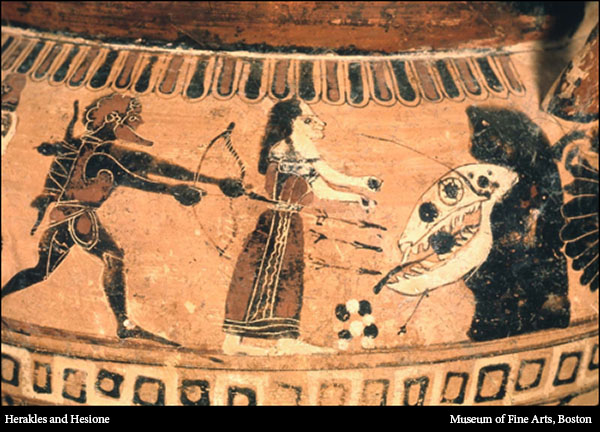
The above image is from the Greek Collection of the Museum of Fine Arts, Boston and complies with their fair use stipulations ... museum accession number 63.420.
Geryon was a three-bodied warrior who grazed his cattle in the far-western land of Erytheia ... he was the son of Khrysaor and Kallirhoe ... Khrysaor was the spawn of the Gorgon, Medusa ... Kallirhoe was an Okeanid—a daughter of Okeanos (Ocean) and Tethys.
Geryon was depicted in a variety of forms because the ancient artists weren't quite sure how a three-bodied man might look ... he's shown with three heads and six feet, one head with three faces and six feet, three winged bodies and other equally unlikely combinations. The written accounts go back as far as Hesiod (eighth century BCE) but the artistic record is much more extensive. This Labor seems to have been a popular theme for the mid-sixth century Attic black-figured vase painters as well as red-figured vases from the end of the fifth century BCE. Several sixth century lekythoi (vases used for oils and ointments) and a seventh century Korinthian pyxis (a container for salves) also show the fight for Geryon's cattle.
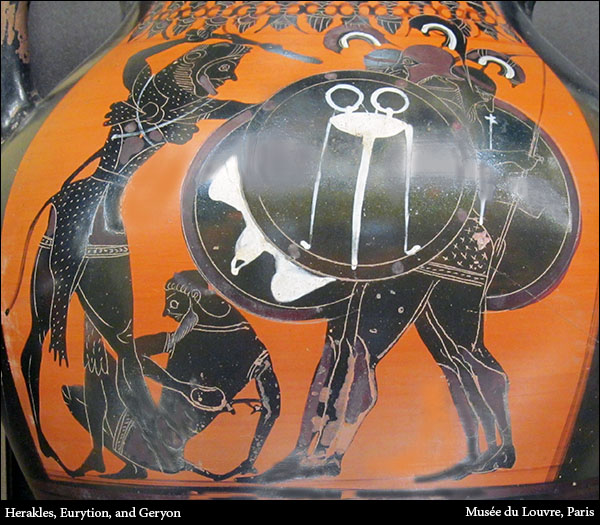
On the long journey to Erytheia, Herakles became so weary of the burning heat of Helios, he raised his bow and shot an arrow at Lord Sun. Helios was so amused at Herakles's impudence that he gave the hero a golden bowl to traverse the western sea. Upon arrival in Erytheia, Herakles promptly slew Geryon's two-headed dog Ortho and after a fierce fight, also killed Geryon and his herdsman, Eurytion. Herakles loaded the cattle into the golden bowl and sailed back to Mykenai.
Two sons of Poseidon, Alebion and Derkynus, tried to steal Geryon's cattle from Herakles and died for their efforts.
Returning with the cattle of Geryon, Herakles became stranded in the land that was later called Skythia—a cold and desolate place.
Herakles camped in the cold winter weather and wrapped in his lion skin, went to sleep. During the night, an unidentified divine presence drove away his horses. When Herakles awoke, he began searching for his mares in a part of the country called Woodland ... instead of his horses, Herakles found a strange female creature in a cave. She was half-woman and half-snake. Herakles was amazed to see her but asked if she had seen his horses. She said she knew where the horses were, but she would only reveal their location if he would mate with her ... Herakles agreed.
Herakles did not seem to be in a hurry to leave the snake-woman and she was in no hurry to return his horses ... nature took its course and they soon had three sons. As was Herakles's way, he was not inclined to stay to play the part of the dutiful father ... he gave the snake-woman his second bow and his belt and told her that whichever of his three sons could string the bow should wear the belt and become ruler of the land ... as for the other two sons, Herakles said that they were to be forced out of the county.
The boys were named Agathyrsus, Gelonus, and Skythes ... of the three, only Skythes was able to string his father's bow ... Agathyrsus and Gelonus were cast out by their mother ... Skythes became king and the country was named Skythia.
The Skythians became a race of notable archers and were easily identified by their distinctive belts, which had a flask attached in the same fashion as the belt Herakles left for his son.
This, the Eleventh Labor of Herakles, was perhaps the most symbolic and definitely the most convoluted of all the Labors. In order to get the Apples of the Hesperides, Herakles had to: 1) find the sea god, Nereus, 2) fight the giant, Antaios, 3) escape death in Egypt at the hands of King Busiris, 4) free Prometheus, from bondage, 5) seek out Atlas, and 6) return the Apples of the Hesperides to Eurystheus.
The nature and timing of this Labor imply that it was the work of the ancient Herakles, i.e. the first Herakles. We know that Herakles freed Prometheus from his chains on the Caucasus Mountains well before the time of the traditional Herakles ... also, Diodorus of Sicily believed that the deeds of the ancient Herakles were centered in Egypt instead of Greece. As for the encounter with Atlas and the Hesperides, this too could have very easily been a deed of the ancient Herakles.
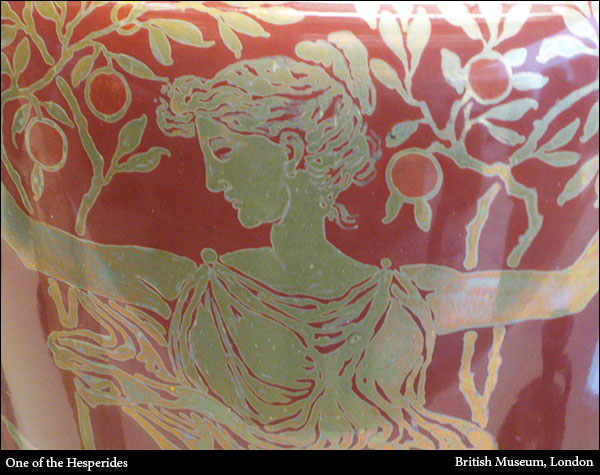
The Golden Apples were originally a wedding gift from Ge (Earth) to Olympian Hera. The apples grew in a garden cultivated by three Nymphs collectively known as the Hesperides—Aegle, Erytheis, and Hespere. The Garden of the Hesperides could easily be imagined as an idyllic grove with beautiful Nymphs basking in eternal spring, but this fanciful scene is quickly dispelled by the sight of Ladon, the multi-headed dragon, guarding the Golden Apples.
In order to find the Garden of the Hesperides, Herakles first had to trap Nereus, the Ancient of the Sea, and force him to reveal the garden's location. Herakles found Nereus asleep and pounced on the ancient god. Nereus struggled to get free by shape-shifting ... he assumed the appearance of various animals and forces of nature but Herakles was dauntless ... Nereus finally relented and reluctantly told Herakles the location of the Hesperides's secret garden.
It would seem that after Nereus divulged the location of the Garden of the Hesperides, Herakles chose to go in the opposite direction ... he went east instead of west. The Garden of the Hesperides is presumed to have been somewhere in the mysterious "west" but after leaving Nereus, Herakles traveled east ... from northern Africa (Libya) to Egypt and then to the Caucasus Mountains ... from the Caucasus Mountains, he finally went westward to northwestern Africa and from there further west to the Garden of the Hesperides.
Herakles proceeded to Libya where he encountered a giant son of Poseidon named Antaios. At that time Libya comprised all of northern Africa west of Egypt. Antaios would not let Herakles pass through his territory without a fight ... it's not clear whether Antaios was killed or simply defeated but, in the end, only Herakles was left standing.
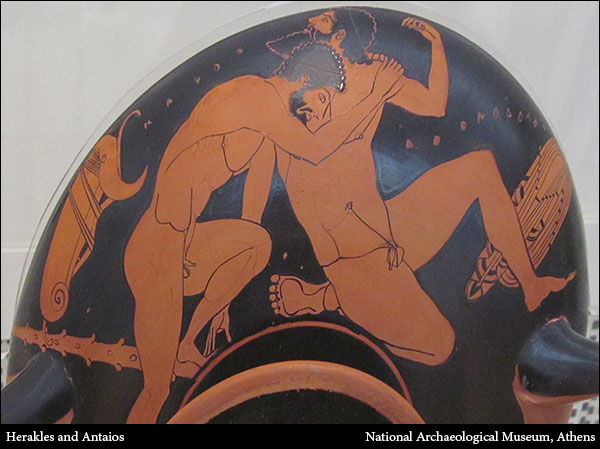
Leaving Libya and traveling east, Herakles ventured into Egypt. King Busiris of Egypt was, like Antaios, a son of Poseidon. An oracle had advised the king that in order to end his nation's drought he must sacrifice a stranger ... it seemed to Busiris that Herakles was the perfect stranger. When Herakles presented himself to Busiris, the king's priests began leading Herakles towards the altar ... realizing their intent, Herakles became enraged ... he killed Busiris and the priests.
The historian and traveler Herodotos raised serious doubts about Herakles's encounter with King Busiris. Herodotos admits that the Egyptians engaged in blood sacrifice, but he also states that the Egyptians did not indulge in human sacrifice. He also doubts that Herakles could have killed the thousands of Egyptians necessary to make his escape.
Continuing his eastward course, Herakles reached the Caucasus Mountains where he found the Rebel-God Prometheus in chains. Prometheus defied Zeus by giving fire and other gifts to the men of the earth. For such an affront to his authority, Zeus commanded the god Hephaistos to shackle Prometheus to the mountain ... to make the punishment more agonizing, each day an eagle would ravage Prometheus's immortal flesh ... each night the flesh would restore itself only to be torn by the eagle the following day. Herakles killed the eagle and freed Prometheus from his chains. Prometheus appreciatively advised Herakles to seek out Atlas for assistance. Atlas, a brother of Prometheus, stood on a mountain in northwestern Africa where he supported the heavens on his shoulders. Atlas agreed to retrieve the Golden Apples from the Hesperides if Herakles would assume his burden and hold up the sky until he returned.
Later writers imagined that Atlas tried to betray Herakles ... they insist that he never intended to resume his burden and that Herakles had to trick him into fulfilling his oath of assistance. The metope from the Temple of Zeus at Olympia seems to exonerate Atlas ... it shows Herakles with the sky on his shoulders while Atlas stands before him placidly offering the Golden Apples ... what really makes this scene dynamic is the figure of Athene standing behind Herakles with one graceful arm extending upwards effortlessly helping to support the weight of the heavens.
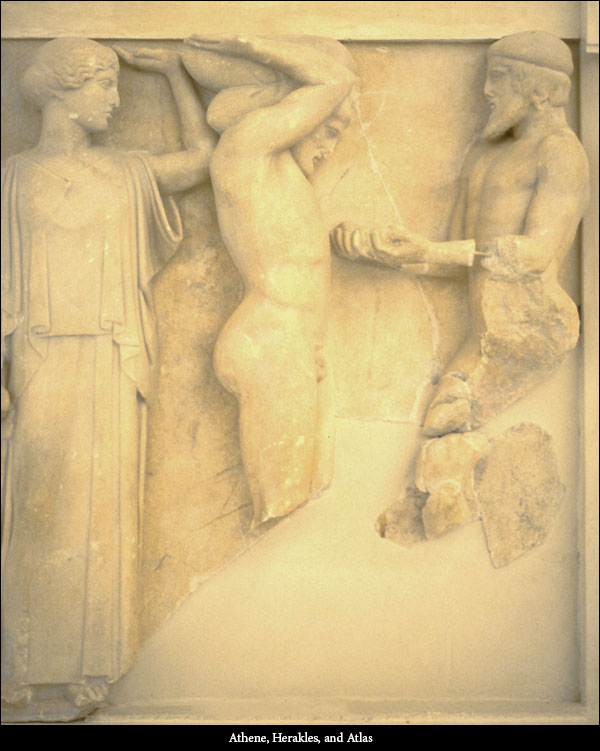
Image from the University of Michigan Library archives
Knowing the troubles Hera routinely inflicted on Herakles, it's surprising that Eurystheus would want to risk her anger by possessing the Golden Apples, which were rightfully hers. Perhaps he thought Hera would blame Herakles for the theft of the Golden Apples and the insult would further inflame her hatred for the son of Zeus's infidelity.
This, the last Labor of Herakles, was the most dangerous and supernatural Labor Eurystheus forced Herakles to endure. Eurystheus insisted that Herakles bring Kerkeros from the Underworld into the light of day. In the Odyssey by Homer, Herakles's "shade" told Odysseus, "I brought back the beast from the House of Hades; Hermes and gray-eyed Athene showed the way."
Kerberos, another offspring of the half-Nymph, half-serpent Ekhidna and the snake-bodied Typhaon was the ferocious watchdog of the House of Hades and usually depicted with three heads, a dragon tail and snakes writhing from his body. The artistic and written descriptions of Kerberos differ as to the number of heads, but the common theme is constant in that he was a beast of untamed savagery who only obeyed the voice of Hades, lord of the dead.
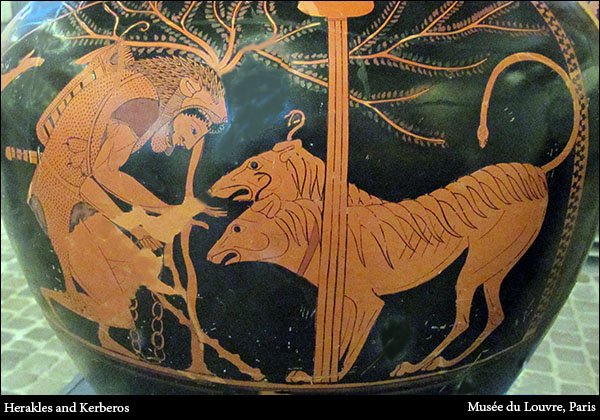
Herakles descended into the Underworld and confronted his uncle, Hades. Either through consideration for Herakles or fear of Zeus's wrath, Hades agreed to let Herakles temporally take Kerberos into the sunlight on the condition that no weapons be used to subdue the beastly hound. Exactly how Herakles was able to capture, and chain Kerberos is not known but with the assistance of Hermes and Athene, Kerberos was led to the court of Eurystheus. The sight of Kerberos was so terrifying, Eurystheus hid in a giant pithos buried in the ground, just as he did at the conclusion of the Fourth Labor—Capturing the Boar of Mount Erymanthos.
The mid-fifth century BCE metope from the Temple of Zeus at Olympia shows Herakles pulling Kerberos from a hole in the ground with Hermes watching, presumably to be sure no harm came to Hades's immortal watchdog.
The Labors were not complete when Herakles joined the crew of the Argo to help Ieson (Jason) and the Argonauts recover the Golden Fleece from the distant land of Kolkhis. Stopping over on the island of Khios, the Argonauts sent a young crewman named Hylas ashore for fresh water. Hylas found the spring of Pegae, which was created when the flying horse Pegasos struck his hoof on the earth. Attracted by Hylas's youthful beauty, the Nymph of the spring pulled him into the water, and he was never seen by mortal men again. Herakles initiated an exhaustive search for Hylas, but the young man could not be found. Herakles went to the nearby city of Mysia and ordered the inhabitants to establish an annual sacrifice to Hylas. Saddened by the ordeal, Herakles decided to leave the Argonauts and return to his Labors.
Stranded in the Libyan desert after stealing the Golden Fleece, the Argonauts encountered the Nymphs known as the Hesperides. Aegle appeared as the trunk of a willow tree, Erytheis as an elm tree, and Hespere as a poplar tree. Aegle told the story of their encounter with Herakles and how he killed the guardian dragon and took their Golden Apples. She also showed the Argonauts the spring Herakles created while he was passing through Libya. Apparently, Herakles simply kicked a rock and fresh water poured onto the desert sands. The grateful Argonauts drank their fill before continuing through the inhospitable terrain.
Aegle's account of how Herakles came into possession of the Golden Apples differed significantly form the "official" version. According to Aegle, Herakles entered the Hesperides's garden and took the Golden Apples whereas the accepted version of the story has Atlas retrieving the Golden Apples and then giving them to Herakles while he waited with the goddess Athene on the shores of Africa.
Concurrent with his Twelve Labors, Herakles had a deadly encounter with a son of Ares, god of war, named Kyknos. Herakles confronted Kyknos because Kyknos had been stealing animals destined for the temple of Apollon at Delphi. The story of Kyknos's violent death was recorded in the poem the Shield of Herakles by Hesiod and, as the title implies, deals primarily with the shield Herakles carried into battle against Kyknos ... it also gives a thrilling account of Herakles's confrontation with Kyknos, and then with Ares. The name Kyknos literally means Swan and is the origin of the Swan-Song, i.e. death-song.
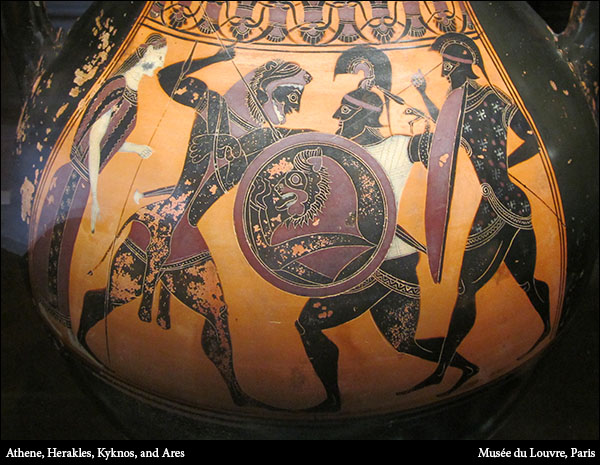
Herakles and Kyknos met in a grove sacred to Apollon. The goddess Athene, Zeus, and Apollon had no doubt as to what the outcome of the contest would be ... Kyknos was going to die and his father Ares could do nothing about it. Herakles was accompanied by his cousin Iolaos ... they entered the grove in a chariot pulled by the horse Arion. Accompanied by Ares, Kyknos thought he could kill Herakles and Iolaos and take their armor.
Herakles had been given an incomparable shield by the immortal artificer, Hephaistos. The technical intricacy and supernatural countenance of the shield gave Herakles the advantage in the mortal combat. Before the two heroes came to blows, the goddess Athene appeared beside Herakles's chariot and informed him that after he killed Kyknos, he could not take Kyknos's armor and horses ... he must wait until after Ares left the field of battle, then he could take Kyknos's armor ... to be certain Herakles and Iolaos understood, Athene shook her aegis (shield) and the earth trembled.
Herakles called to Kyknos and asked him to turn aside and avoid the fight ... he reminded Kyknos of the time he bested Ares in single combat but Kyknos would not be dissuaded from the fight. Zeus thundered and rained drops of blood as a signal to Herakles that the contest should begin ... the two heroes shouted so loudly the surrounding hills echoed with their war-cries.
The two men dismounted from their chariots ... Kyknos was the first to strike ... he stabbed at Herakles, but the divinely crafted shield turned the blow away. Herakles stabbed upwards with his spear and caught Kyknos under the chin with a mighty blow ... Kyknos died before he hit the ground ... he collapsed like a fallen tree ... his bronze armor clashed about him.
As soon as Kyknos fell dead, Ares rushed at Herakles with murderous intent, but Herakles stood his ground. Athene raised her aegis and confronted Ares ... she told him that it was not ordained that he should kill Herakles or take his armor as a prize ... she warned Ares not to withstand her, but he did not heed her warning and hurled his spear at Herakles. Athene reached out and turned the force of the spear aside. Ares pulled his sword and resumed the attack ... Herakles stabbed Ares in the thigh with his spear and knocked the god to the ground. Ares's sons Phobos and Deimos rushed to their father's aid ... they placed him in their chariot and rushed him to the safety of Mount Olympos. As was customary, Herakles and Iolaos stripped the armor from Kyknos's dead body.
Kyknos was given a proper burial by King Keyx in Trakhis with many people attending the ceremonies but Apollon would not put aside his anger ... he asked the river-god Anauros to obliterate Kyknos's grave so no trace of the impious man would remain on the earth. Kyknos died ingloriously at the hands of Herakles and would have been utterly forgotten if not for the poem, the Shield of Herakles.
Upon the completion of the Twelve Labors, Herakles was free of the authority of his cousin, Eurystheus. Without the comfort of a wife or children, he ventured out into the world, not necessarily seeking adventure but more likely to live a life that was not dominated by vengeful Immortals or vindictive relatives.
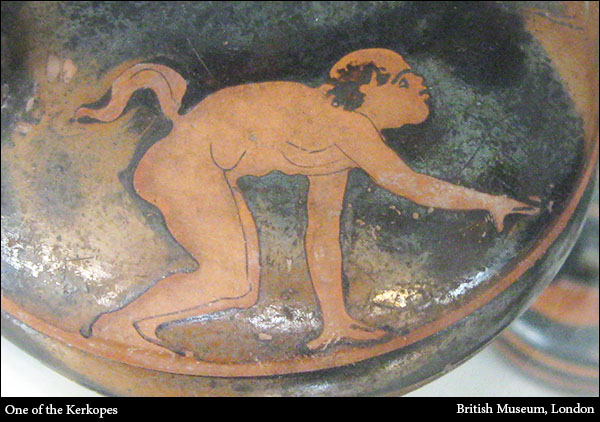
Artwork from the early sixth century BCE has a trivial story that was surprisingly popular throughout Greece (with the exception of Athens) and southern Italy for over two hundred years. As Herakles was sleeping under a tree, two mischievous characters, known as the Kerkopes, stole his bow ... their names were Passalus and Akmon. Herakles caught the barbaric looking brothers and tied them upside-down to a pole, which he carried on his shoulders. The Kerkopes were not only unrepentant but highly amused by their plight ... as they dangled behind Herakles, they began making disparaging comments about Herakles's hairy posterior. Our hero, who was so accustomed to sorrow and brutality, couldn't resist the infectious good humor of the Kerkopes and set them free. It's assumed that this tale was never very popular in Athenian artwork because of their aristocratic sense of humor but they weren't immune to ribald satyr plays which, among other topics, often belittled the Labors and Deeds of Herakles.
Apollon, in repayment of a debt of gratitude, arranged for a goodly man named Admetos to marry a lovely woman named Alkestis.
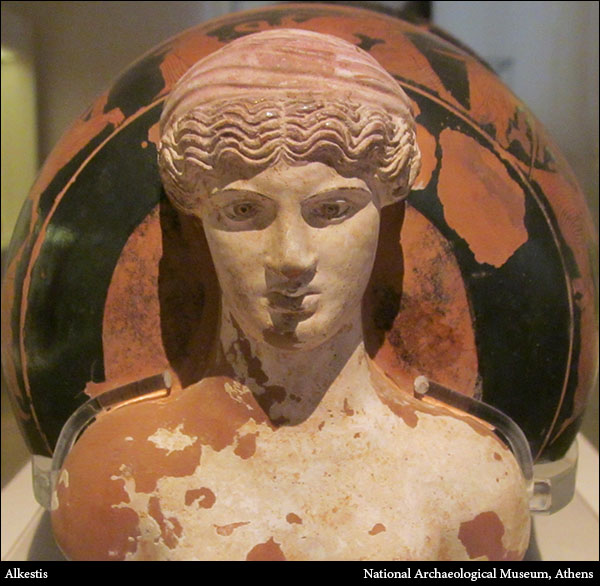
A marriage sanctioned by a god seemed destined for happiness but that was not the case for Admetos and Alkestis. Apollon learned that Admetos was destined to die immediately after the marriage. Refusing to accept such a sad occurrence, Apollon wooed the Eumenides (Furies) with wine until they agreed to allow Admetos to live. The Eumenides were not easily persuaded ... they would only allow Admetos to live on the condition that someone else volunteer to die in his place. Alkestis loved her husband so much that she agreed to die for him.
Herakles heard the story of Alkestis's noble sacrifice and was so moved by such an act of selflessness that he intercepted Thanatos (Death) as he was escorting Alkestis to the Underworld. The noble nature of Alkestis was apparent to Thanatos so he returned her to the land of the living to be reunited with Admetos.
Syleus of Aulis was a villain who made the fatal mistake of trying to force Herakles to work in his vineyard. It's assumed that it was the regular practice of Syleus to stop travelers passing by his farm and force them to toil in his vineyard or be beaten for their refusal. You can certainly guess the outcome of this story ... Syleus tried to force Herakles to work ... Syleus, his family, and all his vines died in the inevitable conflagration.
The artwork of this simple story dates back to the early fifth century BCE but writers, such as Euripides (circa 480-406 BCE), infused the plot with divine intervention as the primary motivation instead of letting it stand as a straight-forward morality tale.
Prince Eurytos of Oikhalia was seeking a manly husband for his daughter, Iole. Eurytos sponsored an archery competition in which the winner would marry the fair Iole. Herakles, as subtle with his bow as he was brutal with his club, entered the contest and won. Eurytos must have known that Herakles had murdered his children and perhaps his first wife, Megara, so it's difficult to blame Eurytos when he refused to allow Iole to marry Herakles ... Herakles did not see it that way ... with no hesitation, Herakles killed Eurytos and his sons and, to add to Iole's dishonor and sorrow, Herakles took her as his mistress instead of his wife.
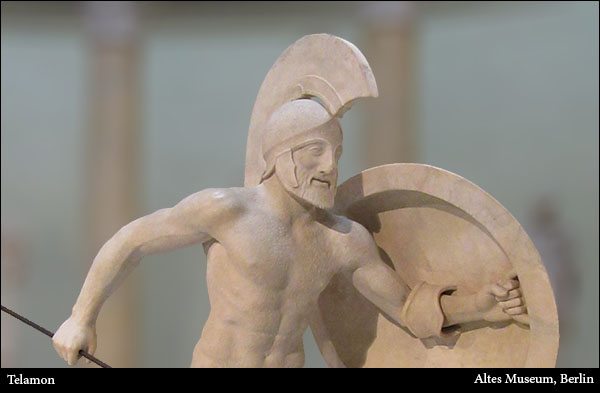
Traveling far and wide, it's not surprising that Herakles would eventually be the guest of King Telamon of the island of Aigina. Telamon and Herakles had been friends for many years ... they served together as Argonauts during the Quest for the Golden Fleece.
Telamon was a fine host. Herakles wanted to repay the kindness so he prayed that Telamon would have an outstanding son. The sincerity of Herakles's prayer prompted Zeus to send an omen in the form of an eagle to signify his blessing. Telamon did not miss the symbolic nature of the eagle ... he named his son Aias, which was taken from the word for eagle (ἀετός). Aias was to become the largest and, second only to Achilles, the fiercest Achaian warrior at the battle for the city of Troy.
The famed biographer Plutarch mentions an encounter between Herakles and a brigand named Termerus. Plutarch described the way in which the hero Theseus emulated the deeds of Herakles by punishing outlaws by their own wicked ways.
Termerus apparently had a thick skull because he killed those he met by butting heads with the hapless strangers. Needless to say, Herakles accepted the challenge and killed Termerus by cracking his skull.
Herakles had competed for Iole and had intended to marry her, but the treachery of her father stilled his desire to make her his wife. The urge to marry and have a family was rekindled by a woman named Deianeira, the daughter of King Oineus of Kalydon.
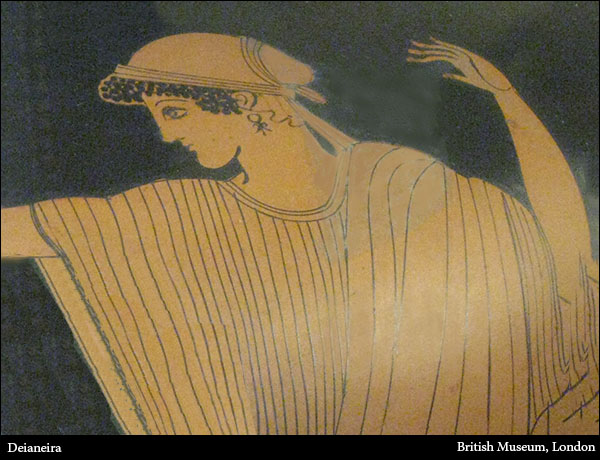
The river-god Acheloos was already courting Deianeira and refused to step aside for Herakles ... a fight began. Artwork as old as 570 BCE documents the struggle between Herakles and the bull-like Arkheloos ... throughout the centuries his appearance varied from bull-like with human features to human-like with bull horns, but the bull countenance was always persistent. The two grappled until Herakles broke off Arkheloos's horns and ended the fight.
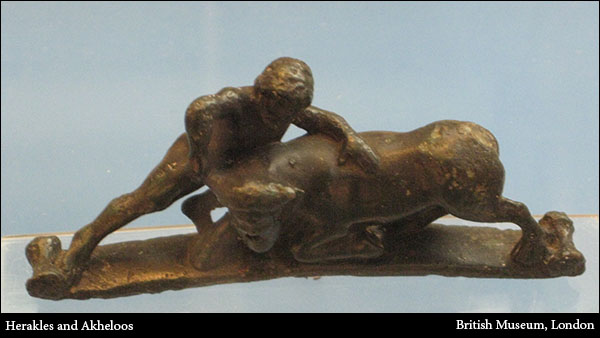
With the blessing of Deianeira's father and the protection of Athene and Nike, Herakles and Deianeira were married and had a son, Hyllos. Sometime later, while they were traveling, they came to the river Euenos where they met the Centaur, Nessos. Feigning civility, Nessos offered to carry Deianeira across the river on his back while Herakles waded across with Hyllos. Nessos quickly transported Deianeira across the river and, with unbridled depravity, tried to forcibly seduce her. Herakles fell on the Centaur with savage fury and moments later Nessos lay bleeding to death on the riverbank. Before he died, he managed to commit one last act of malice ... he secretly told Deianeira that his blood was a powerful love potion ... he said that if she were to put the magic blood on Herakles it would bind him to her forever. Deianeira collected some of Nessos's blood and put it on Herakles's cloak. The result was disastrous ... the blood was poison to Herakles ... it burned him like acid. Deianeira was horrified ... she had mortally wounded the man she hoped to bind with love ... she killed herself in desperation.
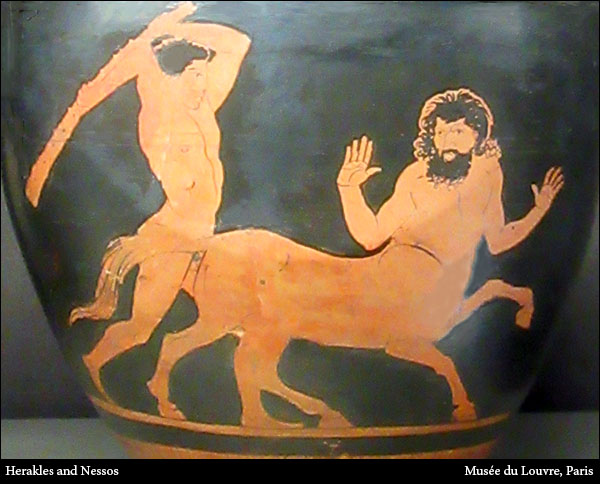
Suffering and desperate, Herakles made his way to Mount Oita and prepared himself for death. As with all the ancient myths, there are many elements that will always remain nebulous ... the death of Herakles is no exception. Later writers said Herakles killed Nessos with an arrow dipped in the poisonous Hydra blood and the combination of the Hydra's blood and the Centaur's blood synergized to make a poison deadly enough to kill the semidivine Herakles. However, artwork, which predates the literary sources by several hundred years, shows Herakles killing Nessos with a sword or club and not arrows.
Herakles laid upon his self-constructed funeral pyre and begged for someone to light the fire ... either the renowned archer Philoktetes or his father Poias finally lit the blaze. In gratitude for the release from his pain and suffering, Herakles gave Philoktetes (or Poias) his famous bow and quiver. Before the flames could consume his essence, Athene (or Nike) lifted Herakles from the fire and took him to Mount Olympos. Philoktetes took Herakles's bow to fight against the Trojans during the siege of Troy ... using the fall of Troy as a datable historical fact, this would put the end of Herakles's mortal life at circa 1260 BCE.
The Immortals welcomed Herakles to Mount Olympos. Even Hera put aside her jealously to receive our hero. As a gesture of her love and acceptance for Herakles, Hera performed a ceremony in front of the other Immortals that symbolized a mother giving birth. She placed Herakles under her gown and as she feigned the agonies of childbirth, Herakles emerged from under the garment as if he was being born ... Herakles was now her immortal son.
Traditionally, there were only twelve Immortals worthy of being called Olympians ... the members of this elite group varied throughout the ages. Zeus offered Herakles one of the twelve seats on Olympos but the indomitable hero refused the honor because he did not want to displace one of the existing Olympians.
Herakles married the sweet stepping goddess Hebe, daughter of Zeus and Hera. He and Hebe had one son, Alexiares.
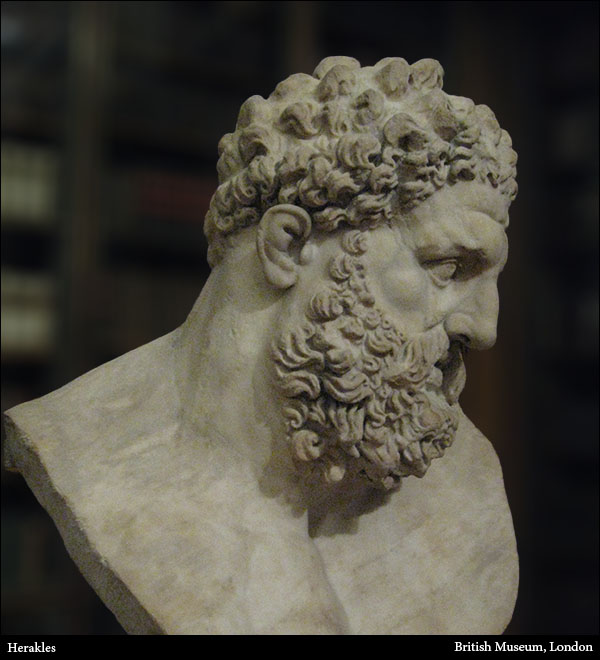
The idea that Herakles was nothing more than a myth seems a bit too simplistic. The Herakleidae, i.e. the descendants of Herakles, ruled parts of Greece and Asia Minor for 505 years after his death. It's difficult to dismiss the possibility that Herakles was a flesh and blood man whose exploits were real in a very literal way. His adventures may have been exaggerated and other hero's exploits were probably superimposed on Herakles's deeds, but the possibility remains that he was a real man and did many of the things attributed to him.
The ancient Greeks had no doubts as to Herakles's reality. Historians like Herodotos (The Histories, book 4, chapter 82) and Xenophon (Anabasis, book 6, chapter 2) recounted Herakles's exploits as actual historical events. Herodotos tells of the time he was visiting the river Tyras in Skythia and shown a footprint in a rock that was said to have been left by Herakles. Although Herodotos may have doubted the authenticity of the footprint, he had no doubt that Herakles had been in Skythia. Xenophon went to the hole in the ground where Herakles was said to have emerged from the Underworld after subduing Hades's dog, Kerberos. Likewise, Xenophon may have questioned the fact that the particular hole he was shown was used by Herakles, but he did not doubt that Herakles had emerged from the Underworld with Kerberos. Those astute and educated men had no misgivings about the reality of Herakles ... neither should we.
The Iliad
The Odyssey
Theogony
Catalogues of Women and Eoiae
Great Eoiae
Catalogue of Women
Shield of Herakles
War of the Titans
Kypria
Returns
Kerkopes
Contest of Homer and Hesiod
The Argonautika by Apollonius of Rhodes
The Histories by Herodotos
Description of Greece by Pausanias
Library of History by Diodorus of Sicily
Library by Apollodorus of Athens
Plutarch's Lives, Theseus XI